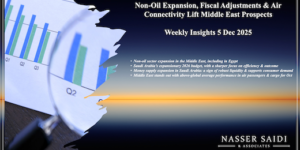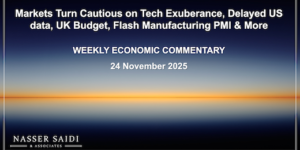Markets
A tumultuous week on markets: though MSCI All-World and US stock indices hit record highs, Fri saw declines on renewed signs of Iran tensions. Regional markets were mostly down as the US-Iran tensions played out (with Iraq caught in the middle). The dollar index posted its best weekly performance in 2 months, but edged down from 4-week high versus the yen and also lower versus the Swiss franc (tmsnrt.rs/2egbfVh). The ongoing tensions in the Middle East seem to have had lesser impact on oil prices (compared to similar previous instances), perhaps an indication of the growing role of non-Middle East based oil producers: oil fell below $65 a barrel, posting its first weekly loss since late Nov. Gold prices rallied to its highest level since Mar 2013 in the beginning of last week, weakening later.
Global Developments
US/Americas:
- Nonfarm payrolls in the US added 145k in Dec down from Nov’s downward revision of 256k. Average hourly earnings grew by just 0.1% mom (the least since mid-2018) and 2.9% yoy compared to the 0.3% mom and 3.1% yoy rise the month before.
- US trade deficit narrowed to a 3-year low of USD 43.1bn in Nov (Oct: USD 46.9bn), as exports climbed by 0.7% amidst a 1% fall in imports. The goods deficit with China fell by USD 2.2bn to USD 25.6bn as imports slipped.
- US ISM non-manufacturing PMI increased to 55 in Dec (Nov: 53.9), with business activity climbing 5.6 points to 57.2.
- Factory orders in the US dipped by 0.7% mom in Nov (Oct: +0.2%) – the 3rd drop in 4 months. Orders for civilian aircraft and parts fell 2.2%, defense aircraft orders plunged 72.9% and orders for non-defense capital goods excluding aircraft gained 0.2%.
- Employment in the US private sector, according to the ADP employment report, rose 202k in Dec (Nov: 124k); the service providers posted the largest gain since Apr.
- Initial jobless claims fell for a 4th week in a row, dropping by 9k to 214k in the week ended Jan 3, with the 4-week moving average down by 9500 to 224k. Continuing jobless claims rose to 1.803mn – the biggest increase since Nov 2015 – from 1.728mn the week before.
Europe:
- Inflation in the EU moved up to a 6-month high, rising to 1.3% yoy in Dec, from 1% the month before. Core inflation remained steady at 1.3% yoy.
- German factory orders slipped by 1.3% mom and 6.5% yoy in Nov (Oct: +0.2% mom, -5.6% yoy), dragged down by a drop in foreign demand (from EU nations by -3.3%, outside the EU by -2.8%) and lower bulk orders. Excluding bulk orders, orders rose by 1% mom.
- Industrial production in Germany increased by 1.1% mom in Nov (Oct: -1%) – the steepest monthly rise in 1.5 years.
- Germany’s trade surplus declined to EUR 18.3bn in Nov (Oct: EUR 20.4bn), after exports declined by 2.3% mom and imports were down by 0.5%.
- EU Economic Sentiment Indicator improved to 101.5 in Dec (Nov: 101.2), driven by higher confidence in services. But, business climate expectations worsened to -0.25 from the previous month’s -0.21 reading.
- German retail sales grew by 2.1% mom, reversing the 1.3% dip in Oct; in yoy terms sales rose by 2.8% yoy from 1.4% yoy the month before. EU retail sales also increased – up 2.2% yoy in Nov vs Oct’s 1.7%.
- Supported by the rise in Markit Services PMI (52.9 in Dec vs Nov’s 52), the Composite PMI moved into expansionary territory (Dec’s 50.2 vs Nov’s 49.4). This upswing was reflected also in EU’s Services and Composite PMI indices: services PMI rose to 52.8 in Dec from 52.4 the month before while the composite index was 50.9 vs Nov’s 50.6.
Asia Pacific:
- Tsai Ing-wen won a second term as the President of Taiwan, in an election dominated by discussions about China’s influence on Taiwan’s democracy.
- Inflation in China remained steady at an 8-year high of 4.5% yoy in Dec, pushed by food costs (+17.4% yoy), especially pork prices (+97% yoy). Producer price index remained in contraction for the 6th consecutive month, falling by 0.5% yoy in Dec vs Nov’s 1.4% drop.
- FDI into China increased by 6% yoy to RMB 845.94bn (USD 124.39bn) during Jan-Nov 2019.
- China’s Caixin services PMI edged lower to 52.5 in Dec (Nov: 53.5), despite a pickup in new orders, and with expectations for business activity falling to the second-lowest level since the series began in 2005.
- India’s industrial output grew 1.8% yoy in Nov after shrinking by 3.8% the month before, boosted by manufacturing output (2.7% vs Oct’s -2.1%). However, production of capital goods contracted in Nov (-8.6%) as did infrastructure and construction goods (-3.5%).
- Singapore’s retail sales improved in Nov, picking up by 0.2% mom after the 2.2% drop the month before. Though, in yoy terms, overall sales fell by 4% and vehicle sales dipped 22.4%.
Bottom line: Coming up this week is the potential signing of the US-China Phase 1 trade deal, as the US-Iran tussle continues (https://econ.st/2FIcCHi): so far this year, the US killed Iran’s top military commander, Iran retaliated with missile attack on US troops in Iraq, US imposed additional sanctions on Iran and rebuffed an Iraqi request to pull out troops (and we are only on Day 12 of 2020!). In the UK, meanwhile, the Parliament approved PM Johnson’s Brexit deal paving the way for UK to leave EU on 31 Jan 2020 (fears of a no-deal exit are no more) even as a BMG survey for The Independent found a 52-48 split in favour of Remain.
Regional Developments
- Oman’s Sultan Qaboos – the longest serving ruler in the Middle East and the last of the founding members of the GCC and an important mediator to multiple feuds in the region – passed away late last week. Former culture minister Haitham bin Tariq Al Said was named the new Ruler, after a sealed envelope nominating him was opened hours after the death: he has since announced that he will continue to uphold Sultan Qaboos’s policies.
- The World Bank expects growth in the MENA region to touch 2.4% in 2020 (2019 growth was estimated at a weak 0.1%), as per the latest Global Economic Prospects issue, citing geopolitical tensions and lower oil demand alongside weaker global growth. Oil prices are forecast to decline slightly to an average of $59 per barrel in 2020 and 2021. (More: https://www.worldbank.org/en/publication/global-economic-prospects)
- Bahrain grew by 1.58% in Q3 2019, supported by 1.99% growth in the non-oil sector while oil GDP dipped by 0.15%.
- Bahrain’s sovereign wealth fund Mumtalakat has hired banks for the potential issuance of a USD denominated sukuk, reported Reuters. This could be the first international debt sale in 2020 by a Gulf borrower.
- Egypt’s PMI inched up to 48.2 in Dec from Nov’s 47.9, though still remaining under the 50-mark that separates expansion and contraction. Output rose to 47.1 from 46.6 (with some firms highlighting liquidity constraints) while new orders stood at 47.9 (Nov: 47).
- Annual urban inflation in Egypt increased to 7.1% in Dec (Nov: 3.6%) while core inflation stood at 2.4% yoy (Nov: 2.1%). The central bank will meet this week and is likely to hold rates steady: overnight rates are currently at 12.25% for deposits and 13.25% for lending.
- Egypt’s first commodities exchange – for spot trading of commodities with large markets – will start trading within the next 36-48 weeks, disclosed the Internal Trade Development Authority head. Commodities to be traded initially will include wheat, sugar, corn and rice that can be produced locally or imported.
- Iraq’s parliament voted “to work towards ending the presence of all foreign troops on Iraqi soil”, after the US attack killed Iran’s top military commander. The US Administration later warned that Iraq could lose access to its central bank account at the Fed if US troops were to be expelled.
- Iraq will likely more than double its crude oil exports to China as part of an oil-for-reconstruction agreement signed last year, disclosed the financial advisor to the Iraqi government. Oil exports are likely to rise to 300k barrels per day from 100k bpd currently.
- Jordan received 1.136 mn barrels of Iraqi crude oil in 2019 (including Dec’s 360k barrels), as part of an MoU signed by the two nations, according to Jordan’s minister of energy. Under the MoU, oil from Iraq will cover 7% of Jordan’s daily demand.
- Jordan’s Q3 2019 GDP grew by 1.9% yoy, with the highest growth rate registered by extractive industries (+7.4%), followed by social and personal services sector (+3.4%) and finance and real estate (+3%).
- The volume of real estate trade in Jordan touched JOD 4.6bn in 2019. Property sales increased by 6% while land sales were up 9%.
- Jordan’s finance minister disclosed that the government repaid overdue arrears to the private sector: JOD 350mn (USD 492mn) during the last week of Dec and 1st week of Jan.
- Kuwait’s oil output in the zone shared with Saudi Arabia is expected to touch 250k barrels per day by end-2020, when production resumes. A 5-year dispute over the area ended last year, and production will restart at 2 jointly-run oil fields that can pump upto 0.5% of the world’s oil supply.
- Kuwait’s Nov foreign reserves accelerated by 3.89% yoy and 3.85% mom to KWD 12.3bn. Money supply in Kuwait declined by 0.3% yoy to KWD 38.219bn (USD 126.352bn) in Nov.
- Tourism revenues in Kuwait surged by 69% yoy to KWD 152.1mn (USD 503.2mn) in Jan-Sep 2019. Spending by Kuwaitis on foreign tourism rose by 21.34% to KWD 4bn during the same period.
- As Lebanon’s multiple crises grow without a functioning government (since Oct), the central bank governor stated that the banks are solvent and will not go bankrupt while deposits remain secure (also insisting that there would be no haircuts on deposits). He also disclosed that contact with the IMF had so far been limited to technical support.
- Total foreign assets at the Central Bank of Oman increased by 2.9% yoy to OMR 6.26bn by end-Oct. M2 grew by 5.2% yoy to OMR 17.52bn while private sector deposits rose by 5.8% to OMR 15.04bn.
- Qatar sold QAR 600mn (USD 164.84mn) of Treasury bills in an auction.
- Qatar Petroleum signed a 15-year agreement to supply Kuwait with up to 3mn tonnes of liquefied natural gas per year, starting 2022. Qatar plans to boost its LNG production to 126mn tonnes a year by 2027.
- PMI in Saudi Arabia fell to a 5-month low of 56.9 in Dec (Nov: 58.3), after business activity slowed (58.1, the lowest since Oct 2018). New orders (down to 64.2 from Nov’s 65.9) and employment remained subdued (50.5).
- Bank credit in Saudi Arabia increased by 5.3% yoy and 1.5% mom to SAR 1.532trn in Nov, thanks to an increase in long-term credit (+17.9% yoy to SAR 601.34bn).
- Saudi Arabia’s investment assets abroad grew by 8.86% yoy to SAR 4.26trn (USD 1.14trn) by end-Q3. FDI was up by 21.3% yoy to SAR 428.12bn, portfolio investments by 19% to SAR 1.04trn while investments in foreign debt instruments rose by 4.3% to SAR 282.38bn.
- The Board of Saudi Arabia’s Capital Market Authority approved the Securities Central Counterparties Regulations, aimed at regulating securities clearing activities and strengthening capital market infrastructure.
- Consumer spending in Saudi Arabia grew by 4.5% yoy to SAR 934.37bn, thanks to a surge in point of sales (+22.6% yoy to SAR 275.39bn).
- Saudi Arabia’s Real Estate Development Fund deposited SAR 1.692bn (USD 451mn) in Dec to the accounts of citizens benefiting from Sakani programme (to allocate residential products for citizens).
- Saudi Arabia announced the issuance of 2,716,858 Umrah visas since the beginning of this year’s Umrah season. Pakistan, Indonesia and India were the largest source nations of the pilgrims.
- Saudi Arabia, in the latest step to boost tourism, will permit visitors to use existing UK, US, and Schengen visas to obtain visitor visas at airport arrivals regardless of citizenship. These visitors need to have used the visa to travel to any one of those countries prior to entry into Saudi Arabia.
- Egypt has the highest number of startup investment deals in the MENA region – 25% of all deals in 2019 – according to MAGNiTT’s 2019 MENA Venture Investment report. 2019 saw a total 564 investments in MENA-based startups amounting to USD 704mn in funding (+13% yoy, excluding the Careem and Souq mega-deals). UAE remained the highest recipient of funding (60% of the total). Saudi Arabia is the fastest growing ecosystem across MENA and ranks third in both number of deals and total funding.
UAE Focus
- UAE’s PMI ended 2019 on a downbeat note, with the reading slipping to 50.2 in Dec compared to Nov’s 50.3. Output continued to slow for a 3rd consecutive month – at 51.6, it was the softest reading over 8 years.
- A Dubai Council was established by Dubai’s ruler to “drive change in Dubai, oversee social and economic governance in the emirate, improve competitiveness, economic leadership and attractiveness of the emirate” and will oversee 6 areas of growth including economy, citizens’ services, government development, infrastructure, security and justice, and health and knowledge. Furthermore, in the first meeting of the Dubai Council, a 50-goal plan for the Emirate was announced, with details to be revealed within 60 days and implemented in the next 5 years. The meeting also approved a new governance system for government and semi-government entities including a separation of the Chairman and CEO roles as well as formation of committees to evaluate investment and risk management.
- Inflation in the UAE fell – for the 11th consecutive month – to 1.4% yoy in Nov (Oct: 1.9%), aided by falling food and beverage costs (-1.13%), textile and clothing (-7.07%) and housing and utilities (-4.17%) among others.
- The UAE announced the rollout of a 5-year multiple entry tourist visa for all nationalities: the details of the visa is expected to be announced soon. UAE welcomed about 21mn tourists last year, with the H1 number at 15mn.
- The value of financial aid and other social benefits provided by the Federal Government to UAE citizens grew by 2% yoy to AED 5.55bn (USD 1.51bn) in Jan-Sep 2019. This accounted for 14.7% of total federal expenses during the period.
- The number of trademarks registered in the UAE increased by 30.5% mom to 1589 in Dec, according to data collected by the Ministry of Economy.
- The UAE received over 3.2mn VAT refund applications from tourists in 2019, according to the Federal Tax Authority (at end-Jun: 1.52mn).
- Dubai registered a total of 41,988 real estate transactions in 2019 – the highest number registered annually since 2008, according to Property Finder. Off-plan properties accounted for 56.3% of the total, though much lower compared to 2017 and 2018 levels.
Media Review
If the threat of war cannot shake stock markets, what can?
https://www.ft.com/content/4737cec2-32d6-11ea-a329-0bcf87a328f2
Central Banks Face a Year of Mounting Challenges
https://www.project-syndicate.org/commentary/fed-ecb-captured-by-financial-markets-by-mohamed-a-el-erian-2020-01
Why was Australia’s government so ill-prepared for the bushfires?
https://www.economist.com/asia/2020/01/09/why-was-australias-government-so-ill-prepared-for-the-bushfires
Lebanon’s Economic Crisis: A Ten Point Action Plan for Avoiding a Lost Decade
https://carnegie-mec.org/2020/01/06/lebanon-s-economic-crisis-ten-point-action-plan-for-avoiding-lost-decade-pub-80704
5G Is 200X Faster and Will Unlock Everything. Here’s Who’s Ready
https://priceonomics.com/5g-is-200x-faster-and-will-unlock-everything-heres/
Powered by:









